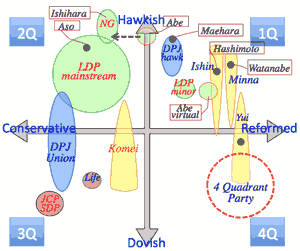>Top 2. 13 arrows for the war:
- [1st arrow] Japanese NSC (National Security Council) Law:
- established in 2013/11/27
- member: Prime Minister, Chief Cabinet Secretary, Minister of MOFA, and Minister of Defense
- originally Chairman of National Public Safety Commission, Minister of Land, Infrastructure & Transport, Minister of METI, Minister of MOF, Minister of Internal Affairs & Communications are included, but became a mere facade
- approval of the Diet is needed in principle
- Information Monitoring:
- will be made, but will be designated as Special Secrets for 30 years, extendable another 30 years.
- It is urged to establish a set of discussion of information laws:
- Committee of the Diet can counsel recommendation (no legal binding force)
- minutes of NSC is to be Freedom of Information Act and Public Records Management Act, and limited range of Specially Designated Secrets, and monitoring by the third party organization.
- Former cases:
- Documents of return negotiation of Okinawa: disclosed in US, but the disclosure was dismiss at the Supreme Court in Japan in 2014/7.
- Document of Fukushima accident in 2011 was disclosed in US after 2 years.
- >Top [2nd arrow] State Secrets Law:
- making secret of the information at NSC.
- also making secret of sensitive administrative information
- request of information disclosure becomes mere facade.
- [3rd arrow] Arms export:
- Defense equipment transfer principle (2014/4/1) abolishing former 'three principles on arms export.'
- Arms export will be approved in the case of contributing international cooperation or national security.
- 2013/5: JBF welcomed arms export as well as joint development of arms.
- 2014/7: approved the export of parts for missile (PAC2) for Qatar.
- Common point of military industry, general contractors, and agriculture cooperative association; which could not be reduced.
- Bellicose country like US, which committed wars 30 times in the last 70 years.
- Military industry expects constant needs of arms by various disputes and wars.
- >Top [4th arrow] Use of collective self-defense:
- The use of force to respond to situations where an armed attack against a foreign country that is in a close relationship with Japan occurs and as a result, threatens Japan’s survival and poses a clear danger to overturn fundamentally its people’s right to life, liberty, and pursuit of happiness, to ensure Japan’s survival, and to protect its people.
- There is no limit of region of self-defense, and possibility of involvement of war as a result increases. (minesweeper, etc.)
- [5th arrow] Quibble over collective self-defense:
- trauma of The Gulf war (1991): 'Show me the flag."; contributed $13.5B
- caused by secret maneuvers by MOFA to realize collective self-defense.
- Collective Security system is the mean to maintain the internal order.
- Collective self-defense can activate without UN Security Council resolution. (coalition of the Willing)
- [6th arrow] Beget and Multiply policy
- Government established numerical goal that the birth rate (fertility rate) should be 2.07 to maintain 100M population after 50 years.; (>Fig.)
- (2.13/1970→1.75/80→1.54/90→1.36/2000→1.26/05(bottom)→1.44/16)
- [7th arrow] Japanese CIA:
- Overseas espionage activity: 2013/11 published by Kyodo News
- Civilian control of these activities.
- [8th arrow] Use of ODA
- ODA budget ¥800B; now is specified to pay attention not to be used arms development and export.
- But government aims to include foreign military support, particularly infrastructure for military use, etc.
- Many NGO/NPO who participate in local activities are embarrassed, opposing such movement.
- [9th arrow] Retention of national defense:
- LDP draft of Article 9 of Revised Japanese Constitution:
- 9-1: In order to accomplish peace, independence, and security of Japanese nation and nationals, Japan will retain the Defense Force with the Prime Minister as the commander-in-chief.
- [10th arrow] Court-martial:
- installation of court-martial; which will be a kind of extraterritorial related to the Defense Force.
- [11th arrow] Restriction of fundamental human rights:
- LDP draft of Article 12:
- The freedoms and rights guaranteed to the people will accompany responsibility and obligation, and such freedoms and rights are subject to public interest and public order.
- LDP draft of Article 21-1:a
- Notwithstanding the said provisions, such activities as to harm public interest or public order, or to make association for it shall not be allowed.
- These drafts may lead to the former National Mobilization Law in the wartime.
- [12th arrow] Conscription:
- Article 18 of Japanese Constitution states: ... Involuntary servitude, except as punishment for crime, is prohibited.
- LDP's some politician insists, conscription is not included in the involuntary servitude, once the Defense Force is authorised in the constitution.
- >Top [13th arrow] Nuclear armament:
- Nuclear power states are authorized to own nuclear arms by NPT system.
- In addition, India, Pakistan, & North Korea, and presumably Israel, Iran own nuclear arms.
- LDP often emphasize that nuclear armament is ultimately effective as deterrent power.
- Japan owns 46.9 tons of Pu (37.1 tons in UK/France, and 9.8 in domestic)
|
2.
戦争をするための13本の矢:
- mere facade: 形骸化
- Japan Business Federation: 経団連
- collective security system: 集団安全保障
- coalition of the willing: 有志連合
- beget and multiply: 産めよ増やせ
- court-martial: 軍法会議
|
- >Top Less population society
少子高齢化の進展
| |
2015 |
2065 |
| Population |
127M |
88M |
| Birth rate |
1.45 |
1.44 |
| Older age ≧65 |
33.9M |
33.8M |
| Product age 15-64 |
77.3M |
45.3M |
| Ratio |
100 |
59 |
| Young age ≦14 |
16.0M |
9.0M |
| Life expectancy ♂ |
81 |
85 |
| Life expectancy ♀ |
87 |
91 |
|
